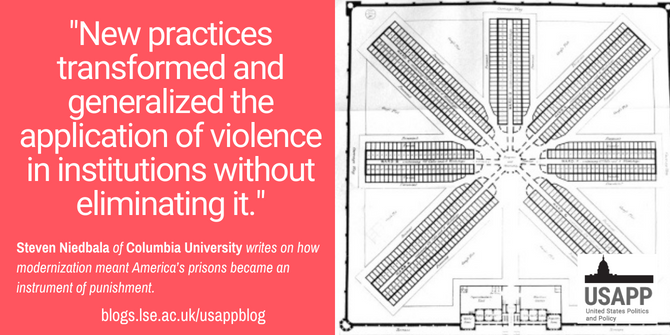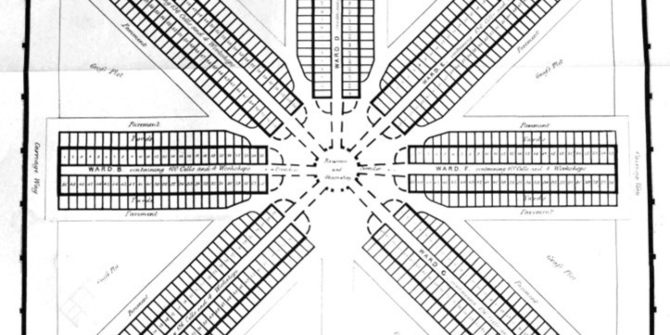The nature of prisons as places where confinement is a form of punishment has made efforts to reform them difficult. Steven Niedbala writes on the history of American prison architecture since the early 19th century. He argues that the ways prisons have been reformed – architecturally and relationally – have simply displaced the punitive nature of the prison system rather than offered genuine change.
In the United States, prison reformers remain divided on the question of how officials and architects should address the archaic, cruel conditions that characterize jails – also known as carceral institutions. While New York City officials recently decided to close the notorious jail on Riker’s Island by 2027, activists have criticized the city’s decision to replace the institution with several new neighborhood facilities . In their view, new institutions, no matter how sleek and modern in appearance, will simply displace problems associated with confinement as a punitive practice. The historical record supports their contention – a glance at federal campaigns for prison reform in the mid-twentieth century demonstrates the problem with reform programs that fail to address the ethics of incarceration as a practice.
Standardizing imprisonment
Since the late nineteenth century, penal reformers have lamented the fact that the United States has lacked a centralized administrative body to oversee the construction and administration of prisons. Individual states were responsible for developing their own prison system, to the extent that reporting on American prison practices for the French government in 1833, Alexis de Tocqueville and Gustave Beaumont noted that national reform efforts ran against the fact that each state “preserve[d] their entire individual independence, and each of them [was] sovereign master to rule itself according to its own pleasure.” This lack of uniformity became more pronounced after the Civil War. During this time, southern legislatures built new prisons on the grounds of former plantations and codified discriminatory legal codes that targeted recently emancipated persons of color. The result was a system of legally sanctioned forced labor that revived the racial order before the Civil War that was thought to have perished with the end of slavery . While northern reformers criticized the unequal application of justice in the south, their efforts were limited to the development of model institutions that failed to improve prison conditions on a national scale.
Between the two world wars, the federal government of the United States launched an effort to standardize law enforcement and judicial practices across the nation. The fight against organized crime during the prohibition era led to the bureaucratization and expansion of the federal law enforcement system under the FBI’s first Director, J. Edgar Hoover. As Congress proscribed new interstate offences under federal law, the few institutions administered by the federal government proved inadequate to handle the expanded population of federal prisoners. In response, Congress formed the Federal Bureau of Prisons in 1930 to oversee the modernization of the federal prison system. Under the leadership of the ambitious penal bureaucrat James V. Bennett, the Bureau launched a campaign to build a national network of new federal institutions and to codify a body of modern penal standards.
Penal reformers and model institutions
While the federal government lacked the authority to intervene directly in the operation of state prison systems, the Bureau used its own modernization campaign as a model for state prison reform. To make modern penology attractive to rural prison administrators, the Bureau had to abandon older models of progressive penology. Throughout the nineteenth and early twentieth centuries, penal reformers largely relied on the development of model institutions to promote standard penal practices. A model institution implied an all-or-nothing approach to the modernization of a facility. Architects and penologists posited the ideal prison as a complex mechanism calibrated to influence the psychological and moral traits of the individual. The adoption of a given model meant that prison administrators had to implement strictly defined disciplinary routines and to follow precise architectural guidelines.
The numerous models proposed by reformers proved inadequate. An unexpected external change such as a sudden increase in the prisoner population could sabotage the complex calculus that governed an institution. Moreover, these models worked under a simplistic understanding of human behavior that often collapsed in the face of reality. For example, reform penologists in the early nineteenth century believed that depriving a prisoner of all human contact would drive them necessarily to remorse and reflection. Eastern Penitentiary in Philadelphia (Figure 1), constructed in 1830 as a demonstration of this principle, featured a variety of techniques to support the isolation of prisoners, including walled individual courtyards and blind skylights. Instead of being moved to penance, however, the prisoners found means of communicating with one another through the plumbing; others suffered from acute and violent forms of mental distress from the lack of human contact.
Figure 1 – John Haviland’s design for Eastern Penitentiary, Philadelphia, PA, 1830

Piecemeal modernization
Abandoning models, the Bureau of Prisons instead developed a comprehensive vocabulary of flexible standards. Over the course of the 1950s and 1960s model, federal officials articulated detailed protocol addressing every level of institutional life. The 1954 Manual of Correctional Standards contained recommendations for such minutiae as the ideal resume for a prison chaplain and the nutritional content of institutional meals. The Bureau emphasized that institutions and state correctional systems could adopt these reforms in a piecemeal way. Modernization would not arrive all at once, but rather through the coordinated adoption of minute adjustments to institutional routines and protocol. If the model relied upon the submission of personnel to the demands of a static formula, the standards circulated in professional journals and publications allowed penal administrators to pursue modernization in a dynamic, gradual fashion.
The process of modernization through standards found reinforcement in contemporary architectural practice. The emergence of new mechanical systems and industrial building components in the early twentieth century. Nineteenth-century architects prized the production of lush perspective drawings and hierarchical plans with complex symmetries. The need to accommodate the technological and infrastructural products of postwar industry demanded new methods. Architects codified a system of standardized units that could describe both mechanical components and the quantitatively defined needs of an average human user; guidebooks published in the interwar period offered extensive data regarding optimal spatial arrangements that could mediate between human users and an increasingly mechanical built environment. The psychological and physiological needs of an occupant were expressed in the same mathematical language that determined the placement of electrical and ventilation services.

For correctional reformers, architecture could help promote modern penal practices where administrators were loath to adopt them. This is exemplified in the case of disciplinary reforms advocated by the Bureau of Prisons. Responding to the brutal corporal punishments meted out in southern prisons, the Bureau proscribed flagellations and beatings in their official literature; instead, they advocated a normalized practice of solitary confinement. In a 1949 architectural guidebook for correctional planners (Figure 2), the Bureau proposed a plan for an ideal cell based upon contemporary data regarding the physical and psychological needs of a generic user. Cells intended for recalcitrant prisoners, however, progressively limited the amount of space and sunlight afforded the occupant. Taken out of the hands of correctional personnel, punishment became a matter determined by minute adjustments to architectural standards.
Figure 2 – Bureau of Prisons guidelines for a standard cell, 1949

The design of environments for solitary confinement implied a cruel form of ergonomics. If contemporary architects were primarily interested in securing the comfort of a user by expressing their needs in the form of data, correctional planners developed a system of gradually intensifying strictures designed to put pressure upon the human body. This principle was reflected in the design of institutions as well. If minimum-security, “reformatory” environments tended to resemble small villages with winding paths and isolated wards, maximum-security prisons compacted living and working arrangements into ever-tighter configurations, as exemplified in a model plan for an Alcatraz-like institution from 1949 (Figure 3).
Figure 3 – Design for a super-security institution by the Federal Bureau of Prisons, 1949

While modernization addressed the immediate infrastructural deficits of state prison systems, new practices transformed and generalized the application of violence in institutions without eliminating it. The ethical principle that guided modernization was aimed less at the standardization of violence through the quantitively defined practice of solitary confinement. Instead, corporal punishment was acceptable when it was taken out of the hands of individual actors and entrusted to the architecture of the institution itself. This reform not only failed to eliminate the routine and unpredictable acts of violence that still characterize prison life today, but also introduced a new, subtle form of restraint that became ever-more pervasive in the American prison system owing to its presentation as a “humane” alternative. Meaningful progress in the present should not merely devise “better” carceral practices but should address the ethical dilemma posed by incarceration itself.
- This article is based on the paper, ‘Measures of Restraint: The Remaking of Carceral Space in the Postwar United States’ in Space and Culture
Please read our comments policy before commenting.
Note: This article gives the views of the authors, and not the position of USAPP – American Politics and Policy, nor the London School of Economics.
Shortened URL for this post: https://bit.ly/3yVKtI6
About the author
Steven Niedbala – Columbia University
Steven Niedbala received his PhD in Art History and Archaeology from Columbia University, where he currently serves as a postdoctoral lecturer. Drawing upon recent works in the history of technology and critical race theory, his work explores the development of contemporary urbanism from a series of “fringe cases” taken from criminological and psychiatric discourse. His research has been published in the journal Grey Room.



